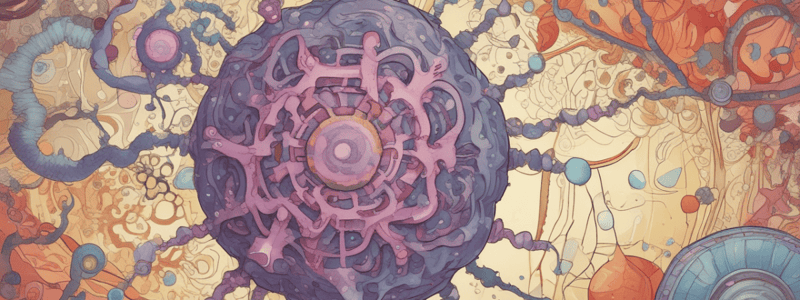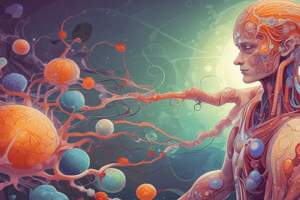Podcast
Questions and Answers
Which of the following cells are phagocytic and play a role in the innate immune response?
Which of the following cells are phagocytic and play a role in the innate immune response?
- Natural Killer Cells
- Macrophages (correct)
- Mast Cells
- Neutrophils (correct)
Which cells are responsible for activating T cells in the adaptive immune response?
Which cells are responsible for activating T cells in the adaptive immune response?
- Dendritic Cells (correct)
- Natural Killer Cells
- Macrophages
- Mast Cells
What is the function of cytokines in the immune response?
What is the function of cytokines in the immune response?
- Mediate cell-cell communication (correct)
- Induce apoptosis
- Form pores in microbial membranes
- Bind to microbial DNA
Which pathway is NOT part of the innate immune system?
Which pathway is NOT part of the innate immune system?
Natural Killer (NK) cells are primarily involved in the innate response to which type of infection?
Natural Killer (NK) cells are primarily involved in the innate response to which type of infection?
Which of these proteins is an acute phase protein?
Which of these proteins is an acute phase protein?
What is the primary role of antimicrobial peptides in the innate immune system?
What is the primary role of antimicrobial peptides in the innate immune system?
Which of the following cells release inflammatory mediators in response to parasites?
Which of the following cells release inflammatory mediators in response to parasites?
What is the main characteristic difference between the innate and adaptive immune responses?
What is the main characteristic difference between the innate and adaptive immune responses?
Which of the following is NOT a role of inflammation in combating infections?
Which of the following is NOT a role of inflammation in combating infections?
Which of the following is a cardinal sign of inflammation?
Which of the following is a cardinal sign of inflammation?
Which cells are the first to be attracted to the site of infection during acute inflammation?
Which cells are the first to be attracted to the site of infection during acute inflammation?
What leads to the accumulation of fluid and proteins at the infection site during inflammation?
What leads to the accumulation of fluid and proteins at the infection site during inflammation?
How do inflammatory cells find their way to the site of infection in the tissues?
How do inflammatory cells find their way to the site of infection in the tissues?
What happens when a pathogen evades or overwhelms the innate immune response?
What happens when a pathogen evades or overwhelms the innate immune response?
Which of the following cell types are considered professional phagocytes?
Which of the following cell types are considered professional phagocytes?
Phagocytosis involves what key initial process?
Phagocytosis involves what key initial process?
Which of these barriers serves to prevent infection by facilitating expulsion?
Which of these barriers serves to prevent infection by facilitating expulsion?
Which of the following mechanisms directly involves the destruction of bacterial cell walls?
Which of the following mechanisms directly involves the destruction of bacterial cell walls?
Reactive Oxygen Intermediates (ROI) produced during phagocytosis include which of the following?
Reactive Oxygen Intermediates (ROI) produced during phagocytosis include which of the following?
Phagosome acidification is a step that precedes which of the following?
Phagosome acidification is a step that precedes which of the following?
Which component in the innate immune system serves to prevent pathogens from colonizing surfaces?
Which component in the innate immune system serves to prevent pathogens from colonizing surfaces?
Flashcards are hidden until you start studying
Study Notes
Mechanisms of Innate Immunity
- Humoral elements are soluble molecules that contribute to the innate response:
- Cytokines: large group of proteins and glycoproteins that mediate cell-cell communication and orchestrate inflammatory and immune responses
- Produced by various cell types, including macrophages, natural killer (NK) cells, and dendritic cells (DCs)
- Examples: interferons, interleukins
Cellular Elements
- Macrophages (sentinel cells):
- Phagocytose microbes immediately
- Release inflammatory mediators (cytokines, lipid mediators, peptides) -> initiates inflammatory response
- Migrate to lymphatic tissue and activate lymphocytes (initiates adaptive response)
- Long-lived cells, undergo multiple rounds of phagocytosis
- Neutrophils:
- Recruited to infection site during inflammatory response
- Highly phagocytic but short-lived
- Dendritic cells (interdigitating):
- Phagocytose microbes
- Migrate to lymphatic tissue and activate T cells (adaptive response)
Antimicrobial Peptides
- Expressed by epithelial cells and neutrophils
- 29-35 amino acids long
- Widespread activity against microbes
- Bind to microbial membranes and form pores
- Some microbes alter cell surface to confer resistance against these peptides
Complement System
- Group of serum proteins
- Important innate mechanism (and adaptive)
- Complement proteins activated by 3 pathways:
- Classical pathway (Ab:Ag complex - adaptive response)
- MBL pathway (innate)
- Alternative (Innate)
- Form pores in target microbes, generate inflammatory mediators, 'activate' phagocytes
Natural Killer Cells
- Found in blood and tissues
- Recognize and kill virus-infected cells (and tumor cells)
- Innate response to viral infection
Mast Cells
- Found in tissues
- Release inflammatory mediators in response to parasites
Other Humoral Elements
- Acute phase proteins (e.g. CRP)
- Collectins (e.g. MBL)
- Lipid inflammatory mediators (e.g. prostaglandins, leukotrienes)
Innate Response
- Important defense system
- Utilizes many effector mechanisms
- Effector mechanisms are shared by adaptive response, making them more efficient
- Inflammation accompanies immune responses and is induced during innate response
Inflammation
- Local response of tissue to damage/infection
- Four roles in combating infections:
- Deliver additional immune effector molecules and cells to infection site
- Activate incoming immune cells
- Provide physical barrier preventing spread of infection
- Promote repair of injured tissue (non-immunological)
- Characterized by redness, heat, swelling, and pain
- These cardinal signs reflect changes in local vasculature:
- Increased vascular diameter -> increased blood flow (heat and redness)
- Increased vascular permeability -> fluid and proteins accumulating at infection site (swelling and pain)
Cellular Migration
- Cells find their way to infection site by following concentration gradient of inflammatory mediators (chemokines)
- During acute inflammation, first cells attracted to site are neutrophils, followed by monocytes (innate)
- In later stages, lymphocytes (adaptive) are also present at infection site
- Mechanisms of cellular migration: Inflammatory mediators produced by macrophages and mast cells 'activate' surrounding endothelium
Studying That Suits You
Use AI to generate personalized quizzes and flashcards to suit your learning preferences.



